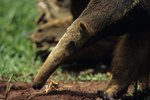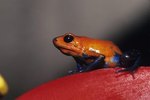
Beetles are remarkably diverse animals; according to the University of Berkley, scientists have formally described more than 350,000 species. Beetles are prevalent in most habitats, but they are particularly numerous in the world’s rainforests. These habitats have produced an extraordinary diversity of beetles as well as of predators that eat these plentiful insects.
Mammals
Because beetles are small and relatively defenseless creatures, a variety of mammals hunt them. Rodents and small carnivores frequently consume beetles, and at least one primate -- the bizarre aye-aye (Daubentonia madagascariensis) has special adaptations for finding hidden beetle larvae and other insects. Using his impeccable hearing to find beetles inside logs and trees, the aye-aye uses his long third digit to pull the tasty beetles out of their holes. Not even the Hercules beetle, with his incredible strength, is safe from beetles' two most important predators: rats and bats.
Lizards
Lizards are important predators of both rainforest beetles and their calorie-rich larvae. The long tongue of panther chameleon (Furcifer pardalis) enables it to catch beetles flying or crawling near it. Large geckos like tokay (Gekko gecko) and white-lined geckos (Gekko vittatus) consume small and medium-size beetles who are active at night. Though beetles' hard exoskeletons provide some protection from extremely small lizards, even the largest beetle species must avoid monitor lizards. Green (Varanus prasinus) and black (Varanus beccarii) tree monitors consume beetles they find crawling in the trees, while even the largely frugivorous Gray’s monitor (Varanus olivaceus) eagerly consumes terrestrial beetles.
Frogs
Frogs are not discriminating when it comes to food; if it moves and will fit in the mouth, it is food. Among the numerous invertebrates that make up the diet of frogs, beetles figure heavily. Many beetles are attracted to the water-holding flowers in the rainforest canopy, but unfortunately for the beetles, frogs -- especially red-eyed tree frog (Agalychnis callidryas) -- live in these same flowers, waiting to consume the insects. Occasionally, the tables turn: Predatory diving beetles sometimes consume small frogs and other creatures. Many of the rainforest frogs with large mouths, like the appropriately named Pacman frogs (Ceratophrys sp.), eagerly consume beetles in addition to anything else that crawls by.
Birds
Birds are important predators of adult beetles and their larvae. While many birds are able to catch poor-flying beetles in midair, some birds seek out beetles and other insects where they hide. In addition to drilling into the wood to search for food, the lesser yellow-naped woodpecker (Picus chlorolophus) hunts for beetles crawling on the bark of trees. Big birds readily eat even the heaviest insect on the planet -- the Goliath beetle (Goliathus goliatus).
Invertebrates
Ground-dwelling spiders capture beetles as they crawl along the ground or through subterranean burrows; web-spinning species capture beetles in flight. Tree dwelling tarantulas, like the pink-toe tarantula (Avicularia avicularia) capture beetles inside tree hollows high in the canopy. Centipedes, large mantises and scorpions will also consume beetles from time to time. Additionally, larger, predatory beetles will hunt and eat smaller species.
References
- Animal Diversity Web: Daubentonia Madagascariensis
- A-Z Animals: Hercules Beetle
- Animals of the Rainforest: Goliath Beetle
- University of California, Berkeley: Case Study: Why So Many Beetles?
- Fort Wayne Children's Zoo: Black Tree Monitor
- Mampam Conservation: Varanus Olivaceus
- Woodpeckers; Hans Winkler and David A. Christie
- AmphibiaWeb: Agalychnis Callidryas
- MyFoxPhilly.com: Museum Battling Cannibalistic Beetles
- Tokay Gecko Guide: 5 Nutritious Foods for Your Tokay Gecko
Photo Credits
-
David De Lossy/Photodisc/Getty Images



